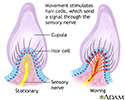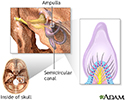Dizziness
Lightheadedness - dizzy; Loss of balance; Vertigo
Dizziness is a term that is often used to describe 2 different symptoms: lightheadedness and vertigo.
Lightheadedness is a feeling that you might faint.
Vertigo is a feeling that you are spinning or moving, or that the world is spinning around you. See also: Vertigo-associated disorders
Vertigo-associated disorders
Vertigo is a sensation of motion or spinning that is often described as dizziness. Vertigo is not the same as being lightheaded. People with vertigo...

Considerations
Most causes of dizziness are not serious, and they either quickly get better on their own or are easy to treat.
Causes
Lightheadedness occurs when your brain does not get enough blood. This may occur if:
- You have a sudden drop in blood pressure.
- Your body does not have enough water (is dehydrated) because of vomiting, diarrhea, fever, and other conditions.
- You get up too quickly after sitting or lying down (this is more common in older people).
Lightheadedness may also occur if you have the flu , low blood sugar , a cold, or allergies.
Flu
The flu is an infection of the nose, throat, and lungs. It spreads easily. This article discusses influenza types A and B. Another type of the flu ...

Low blood sugar
Low blood sugar is a condition that occurs when the body's blood sugar (glucose) decreases and is too low. Blood sugar below 70 mg/dL (3. 9 mmol/L) i...

More serious conditions that can lead to light-headedness include:
- Heart problems, such as a heart attack or abnormal heart beat
- Stroke
- Bleeding inside the body
- Shock (extreme drop in blood pressure)
If any of these serious disorders are present, you will usually also have symptoms like chest pain, a feeling of a racing heart, loss of speech, change in vision, or other symptoms.
Vertigo may be due to:
-
Benign positional vertigo
, a spinning feeling that occurs when you move your head
Benign positional vertigo
Benign positional vertigo is the most common type of vertigo. Vertigo is the feeling that you are spinning or that everything is spinning around you...
Read Article Now Book Mark Article -
Labyrinthitis
, a viral infection of the inner ear that usually follows a cold or flu
Labyrinthitis
Labyrinthitis is irritation and swelling of the inner ear. It can cause vertigo and hearing loss.
 ImageRead Article Now Book Mark Article
ImageRead Article Now Book Mark Article -
Meniere's disease
, a common inner ear problem
Meniere's disease
Ménière disease is an inner ear disorder that affects balance and hearing.
 ImageRead Article Now Book Mark Article
ImageRead Article Now Book Mark Article
Other causes of lightheadedness or vertigo may include:
- Use of certain medicines
- Stroke
- Multiple sclerosis
- Seizures
- Brain tumor
- Bleeding in the brain
Home Care
If you tend to get light-headed when you stand up:
- Avoid sudden changes in posture.
- Get up from a lying position slowly, and stay seated for a few moments before standing.
- When standing, make sure you have something to hold on to.
If you have vertigo, the following tips can help prevent your symptoms from becoming worse:
- Keep still and rest when symptoms occur.
- Avoid sudden movements or position changes.
- Slowly increase activity.
- You may need a cane or other help walking when you have a loss of balance during a vertigo attack.
- Avoid bright lights, TV, and reading during vertigo attacks because they may make symptoms worse.
Avoid activities such as driving, operating heavy machinery, and climbing until 1 week after your symptoms disappear. A sudden dizzy spell during these activities can be dangerous.
When to Contact a Medical Professional
Call your local emergency number (such as 911) or go to an emergency room if you are dizzy and have:
- A head injury
- Fever over 101°F (38.3°C), headache, or very stiff neck
- Seizures
- Trouble keeping fluids down
- Chest pain
- Irregular heart rate (heart is skipping beats)
- Shortness of breath
- Weakness
- Inability to move an arm or leg
- Change in vision or speech
- Fainting and loss of alertness for more than a few minutes
Call your health care provider for an appointment if you have:
- Dizziness for the first time
- New or worsening symptoms
- Dizziness after taking medicine
- Hearing loss
What to Expect at Your Office Visit
Your provider will perform a physical exam and ask questions about your medical history and symptoms, including:
- When did your dizziness begin?
- Does your dizziness occur when you move?
- What other symptoms occur when you feel dizzy?
- Are you always dizzy or does the dizziness come and go?
- How long does the dizziness last?
- Were you sick with a cold, flu, or other illness before the dizziness began?
- Do you have a lot of stress or anxiety?
Tests that may be done include:
- Blood pressure reading
-
Electrocardiogram (
ECG
)
ECG
An electrocardiogram (ECG) is a test that records the electrical activity of the heart.
 ImageRead Article Now Book Mark Article
ImageRead Article Now Book Mark Article - Hearing tests
-
Balance testing (
ENG
)
ENG
Electronystagmography is a test that looks at eye movements to see how well two nerves in the brain are working. These nerves are:Vestibular nerve (...
Read Article Now Book Mark Article - Magnetic Resonance Imaging (MRI)
Your provider may prescribe medicines to help you feel better, including:
- Antihistamines
- Sedatives
- Anti-nausea medicine
Surgery may be needed if you have Meniere's disease.
References
Baloh RW, Jen JC. Hearing and equilibrium. In: Goldman L, Schafer AI, eds. Goldman's Cecil Medicine . 25th ed. Philadelphia, PA: Elsevier Saunders; 2015:chap 428.
Chang AK, Olshaker JS. Dizziness and vertigo. In: Marx JA, Hockberger RS, Walls RM, eds. Rosen's Emergency Medicine. 8th ed. Philadelphia, PA: Elsevier Saunders; 2014:chap 99.
Post RE, Dickerson LM. Dizziness: a diagnostic approach. Am Fam Physician . 2010 Aug 15;82(4):361-8, 369.
-
Carotid stenosis, X-ray of the left artery - illustration
A carotid arteriogram is an x-ray study designed to determine if there is narrowing or other abnormality in the carotid artery, a main artery to the brain. This is an angiogram of the left common carotid artery (both front-to-back and side views) showing a severe narrowing (stenosis) of the internal carotid artery just beyond the division of the common carotid artery into the internal and external branches.
Carotid stenosis, X-ray of the left artery
illustration
-
Carotid stenosis, X-ray of the right artery - illustration
This is an angiogram of the right carotid artery showing a severe narrowing (stenosis) of the internal carotid artery just past the carotid fork. There is enlargement of the artery or ulceration in the area after the stenosis in this close-up film. Note the narrowed segment toward the bottom of the picture.
Carotid stenosis, X-ray of the right artery
illustration
-
Vertigo - illustration
Rotational head movements cause the fluid in the cupula of the semicircular canal to "bend" the hair cells. The hair cells, in turn, send a signal to your brain that you are experiencing "motion". Vertigo can occur when these hair cells are still sending signals of motion, even though you may be perfectly still, giving you the "illusion of movement".
Vertigo
illustration
-
Balance receptors - illustration
Deep inside the head is the inner ear, which contains 3 small, fluid-filled structures called the semicircular canals (ducts). Each duct has a swelling at the end called the ampulla. Within the ampulla are tiny "balance" receptors called crista.
Balance receptors
illustration
-
Carotid stenosis, X-ray of the left artery - illustration
A carotid arteriogram is an x-ray study designed to determine if there is narrowing or other abnormality in the carotid artery, a main artery to the brain. This is an angiogram of the left common carotid artery (both front-to-back and side views) showing a severe narrowing (stenosis) of the internal carotid artery just beyond the division of the common carotid artery into the internal and external branches.
Carotid stenosis, X-ray of the left artery
illustration
-
Carotid stenosis, X-ray of the right artery - illustration
This is an angiogram of the right carotid artery showing a severe narrowing (stenosis) of the internal carotid artery just past the carotid fork. There is enlargement of the artery or ulceration in the area after the stenosis in this close-up film. Note the narrowed segment toward the bottom of the picture.
Carotid stenosis, X-ray of the right artery
illustration
-
Vertigo - illustration
Rotational head movements cause the fluid in the cupula of the semicircular canal to "bend" the hair cells. The hair cells, in turn, send a signal to your brain that you are experiencing "motion". Vertigo can occur when these hair cells are still sending signals of motion, even though you may be perfectly still, giving you the "illusion of movement".
Vertigo
illustration
-
Balance receptors - illustration
Deep inside the head is the inner ear, which contains 3 small, fluid-filled structures called the semicircular canals (ducts). Each duct has a swelling at the end called the ampulla. Within the ampulla are tiny "balance" receptors called crista.
Balance receptors
illustration
Review Date: 4/11/2015
Reviewed By: Linda J. Vorvick, MD, Medical Director and Director of Didactic Curriculum, MEDEX Northwest Division of Physician Assistant Studies, Department of Family Medicine, UW Medicine, School of Medicine, University of Washington, Seattle, WA. Also reviewed by David Zieve, MD, MHA, Isla Ogilvie, PhD, and the A.D.A.M. Editorial team.




